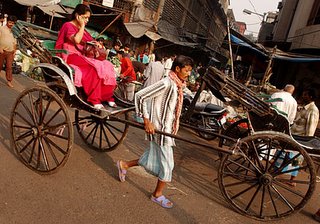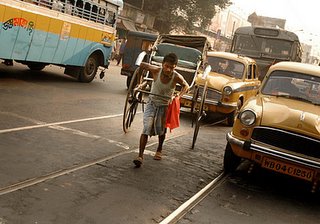My city !
From "The Economist" magazineTHE arriving businessman, anxious to get to grips with India's information-technology industry in its very capital, may need a little patience. He might meet his first traffic jam just outside Bangalore's airport. He can examine the skeleton of the early stages of a planned flyover on the airport road. Construction started in February 2003 and was due to be completed in April 2004. Three-quarters of the work is still to be done, but the building site is idle. A dispute over cost escalation led to a cancellation of the contract (the rusting steel that forms the skeleton was getting more expensive by the day).
To say the least, this is bad public relations for Bangalore, the hub of the great Indian boom in software and remote services, such as call-centres (known as “business process outsourcing”, or BPO). It seems to confirm recent scare stories that the city has ground to a halt, and its government does not care. Late last year, some of the leading lights of Indian information technology (IT), such as Wipro's founder, Azim Premji, and his counterpart at Infosys, Narayana Murthy, gave warning that Bangalore was in trouble. The Indian Express, a national newspaper, took up the cause with a front-page series on “Bangalore crumbling”.
The government showed its disdain for the IT billionaires by allowing the withering of the “Bangalore Agenda Task Force”. This was an initiative led, and largely financed, by Nandan Nilekani, chief executive of Infosys, to improve governance and infrastructure in Bangalore through partnership with the private sector. Worse still, from the IT industry's point of view, the government decided to apply an “entry tax” of 13.5% on goods brought into the state—a big burden on firms relying on imported computers.
For those perennially pessimistic about India, all this was just the latest proof that its democratic structure will always end up stifling its economic prospects. Bangalore alone accounts for about one-third of India's software exports and, with 265,000 workers, nearly one-third of total employment in IT services and BPO. No other Indian city has such an “ecosystem” of mutually reinforcing strengths. So one would expect Bangalore's woes to have a nationwide impact.
Yet Wipro and Infosys are taking on nearly 1,000 new staff every month. There were jitters this month on the stockmarket after Infosys forecast a sluggish quarter ahead. But NASSCOM, the industry's lobby, expects Indian IT services to continue to grow by 25-28% annually. BPO, from a much smaller base, will grow even faster, by 35-40%. The three biggest Indian IT firms—Tata Consultancy Services, Infosys and Wipro—are now among the top ten globally in terms of stockmarket capitalisation, gross profits and employees.
There are a number of explanations for this paradox. First, Bangalore's troubles, while serious, are not terminal. Second, India has plenty of other locations for IT and BPO investment. But third, and most important, these are still businesses with fantastic potential, and India's advantages are so great that, however bad its aim, it will be hard-pressed to shoot itself in the foot.
Bangalore, say officials, is the fastest-growing city in India. Its population, only 800,000 in 1951, had grown to 5.6m in 2001, and is estimated at 7m now. It appealed to the British Raj's soldiers—and then to Indian pensioners—because of its beautiful, mild climate, the finest in India, and the lush greenery of its many parks and gardens.
That still helps draw the IT industry, as do its technical and scientific institutes. It is home to the Indian Institute of Science, singled out in the Indian budget this year as a centre of excellence in research and development to be promoted as a “world-class university”, as well as the location of the organisation spearheading India's space programme. Karnataka has 77 engineering colleges producing more than 29,000 graduates a year.
Now, to these attractions are added an abundance of talent, a relaxed and cosmopolitan atmosphere, and a lively nightlife. Many recent graduates come, at their parents' expense, to hunt for a job. The big IT firms have built huge campuses in Electronics City, a few kilometres out of town. Some are as modern and efficient as anything in Silicon Valley, from the state-of-the-art remote network-management systems to the cappuccino bars.
But commuting is a nightmare. Bangalore suffers the infrastructure shortcomings common to many Indian cities: a water shortage, inadequate sewers, an erratic power supply, and pot-holed roads too narrow for the traffic they need to bear. But Bangalore may be unique in the speed of its decline. Samuel Paul of the Public Affairs Centre, an outfit that monitors the government's performance, says it shows that just a few months of neglect are enough to undo years of improvement. Hearing the negative signals about Bangalore that the new government sent out, many city workers stopped bothering. The result: “total urban chaos”, according to Sudip Banerjee, boss of Wipro's “enterprise solutions” division.
But this chaos has not infiltrated the Wipro campus, however, nor those of its competitors. They build much of their own infrastructure. Their virtual connections to the West sometimes seem stronger than their physical ties to India. “Our body is in India,” says Mr Nilekani, “but our head is in New York or somewhere.” So the impact of “crumbling” is diluted. In the long run, it may make Bangalore a less attractive destination. But firms still have to coax Bangalore-based staff with incentives to move elsewhere.
Few in the IT industry have much good to say about the new government. At least, however, it is pretending to be friendly to business. It has dropped the entry tax for exporting firms and is even talking of setting up a committee with the private sector, along the lines of Mr Nilekani's defunct task-force. All its talk of expansion will inevitably be bogged down in bureaucratic delay, and the building will itself cause disruption. Things will get worse before they get better. But are they now, or will they become, very much worse than elsewhere in India? Probably not.
Bangalore's troubles will, however, encourage local and foreign firms to examine the many other options available. It used to be, says Partha Iyengar of Gartner, a consultancy, echoing an old IBM advert, that in the IT industry, “no one ever got fired for choosing Bangalore”. Now the city is a “drastic victim of its own success” that is becoming less and less attractive. For the most sophisticated work, in research and development, Philips's Mr Hoekstra argues there is still no alternative: “if Bangalore sinks, India sinks”. But he wishes the Karnataka government had deterred the call-centres. For them, and many other BPO activities, there is plenty of choice.
Gartner has classified Indian cities in four “tiers” of attractiveness to foreign firms seeking to outsource work to India. Bangalore, along with Delhi and Mumbai, occupies the top tier. But it lists six places as “Tier 1-1” cities, just behind the leaders. They are Gurgaon and Noida, the fast-growing towns on the edges of Delhi; Mumbai's new town; Chennai (formerly Madras) and Hyderabad in the South and Pune in the West. Then there is a whole range of places just below that vying for business. Last month Dell, an American computer giant, opened a contact centre in Mohali in the north. Kolkata (once Calcutta) is trying to shed its image as a bastion of labour militancy and is aggressively courting investment in IT and BPO.
Most of the big Indian IT firms and many of the smaller ones have operations in several Indian cities. Vee Technologies, a BPO firm with its headquarters in Bangalore, employs 300 people there for its “high-cost work”, but about 500 in the town of Salem, about three hours away, where costs are lower and staff far easier to retain. Lakshmi Narayanan of Cognizant, an American IT firm with its main Indian base in Chennai, says IT job-hunters are starting to move there and to Hyderabad to look for work, as they do to Bangalore. Chennai alone has an estimated 100,000 software professionals, and is expected to add another 50,000 this year.
Mr Narayanan says companies such as his worry more about mounting costs than they do about the infrastructure. Bangalore, with the influx of foreign firms pushing up wages, is where they are mounting fastest. P.V. Kannan, boss of 24/7 Customer, a BPO firm, reckons the city is about 10% more expensive than other places in India. Staff attrition—running as high as 40% for the industry as a whole, and even higher at the lower end of the call-centre market—is a particular problem because of all the foreign firms.
The successful firms are expanding aggressively. OfficeTiger expects to double the number of its employees to about 4,000 by the end of the year. 24/7 Customer added 1,200 people in the past year, and has 4,200 now. It expects to grow by 40% this year and next.
Optimism about India's prospects in these businesses is based, firstly, on the sheer range of work now encompassed by the IT and BPO industries and, second, on its potential for further expansion. The business that started it all—offshore software development—still has plenty of room to grow. The world becomes more dependent on IT by the day. Even as new applications are churned out, old ones need maintaining and even newer ones developing.
The qualities of those graduates give India its biggest competitive advantage and, in the long run, the one that gives most cause for concern. Partha Iyengar of Gartner forecasts that in 5-7 years' time, many of the software processes at present performed manually in offices in Bangalore will be automated. India will have to move upmarket and “who is going to convert the army of programmers into businessmen?”
The biggest constraint on the growth of India's service industries may be the available talent pool. Nevertheless, the bullish projections for Indian IT and “IT-enabled services” produced in 2002 by NASSCOM and McKinsey seem within reach. They forecast that the combined industries would, by 2008, employ 4m people (up from fewer than 900,000 in 2004), earn $57 billion-65 billion from exports (compared with $17 billion in 2004), and account for 7% of GDP (compared with 4%).
The challenge this poses for the firms leading the boom is how to expand fast enough to meet demand without jeopardising quality. For quality, as much as cost, is what is driving the demand. It is in this context that Bangalore's troubles have to be seen: as the acute growing pains of a still-infant industry. It is a worry not because the difficulties are insuperable, but because some can be solved only by the government. India's IT industry has thrived in part because, unlike most other sectors of the economy, it has largely kept the government out of its business. That period is coming to an end. Neglect, the industry is learning, is not always benign.






